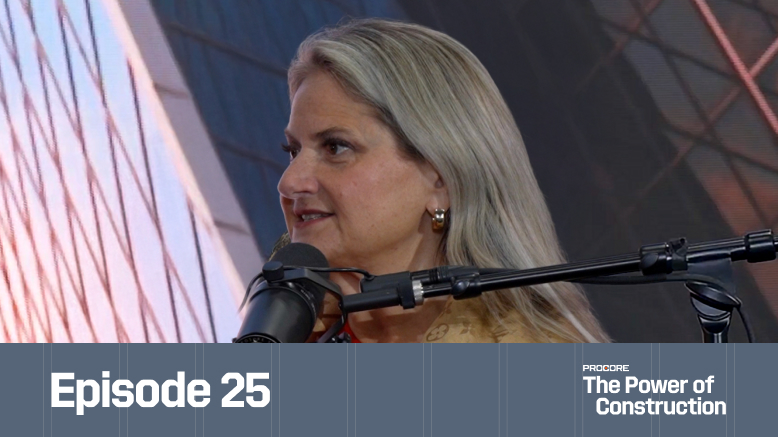— 8 min read
Building Buy-In: 8 Keys to Improving Tech Adoption in Construction


Last Updated Aug 19, 2024

Steve Schultz
Business Analyst
Steve Schultz brings more than two decades of experience in construction to his current role as Business Analyst at James G. Davis Construction (DAVIS). He has also held pivotal roles at various organizations, including BF Joy, Berkeley Research Group, Olson Engineering, and Donohoe Construction Company. Not only has Steve demonstrated expertise in business development, project management, and risk analysis, but he also earned specialized certifications, including Procore's Project Manager credentials and being a Certified Aging-in-Place Specialist (CAPS). His extensive background encompasses underground infrastructure, structural health monitoring, and pre-construction services, making him a valuable asset in data analytics, claims management, and technical support in construction projects. Steve is based in the Washington D.C. area.

Jonny Finity
Senior Content Manager
28 articles
Jonny Finity creates and manages educational content at Procore. In past roles, he worked for residential developers in Virginia and a commercial general contractor in Bar Harbor, Maine. Jonny holds a BBA in Financial Economics from James Madison University. He lives in New Orleans.
Last Updated Aug 19, 2024

Over the years, the construction industry has seen significant changes. New software and tools can be exciting, but without the right approach to evaluating and implementing new technology, even the best solutions can be a drain on resources and morale. Securing buy-in from leaders and getting jobsite teams to adopt new software are two equally important challenges to solve. In this article, we’ll explore some proven strategies for improving tech adoption and increasing buy-in within a construction company.
Table of contents
1. Prioritize data integration.
Construction companies typically have two main systems:
- An ERP (Enterprise Resource Planning) system is used to manage accounting and office operations
- A production management system is used to manage project activities and job-level data
Integration between these two platforms is key. In addition, all other software applications that make up the company’s tech stack really need to integrate with one or both of these platforms so data is fully accessible to the core systems for comprehensive analysis and reporting.
When considering new technology, construction teams have to consider how data is shared, where it is shared and how it is integrated. Companies should look for systems that offer Application Programming Interfaces (API)s and other options to pass data between software platforms. The ease of integration with other apps is as important as the software’s functionality.
One of the first things we consider, beyond the product's actual functionality, is data sharing. We look at where and how the data is shared, and whether there are APIs to allow data reuse without manual retyping. This remains a significant issue even today.

Steve Schultz
Business Analyst
James G. Davis Construction Corp
2. Understand executive needs.
Strong support from leadership is essential for new technology to gain traction. Sometimes construction executives can be resistant to change, especially when they are not part of the plan. To address this, it is helpful to get executives involved early. It’s important for company leaders to understand the benefits — and expectations — of any new technology.
It is very difficult to bubble up from the bottom if there isn't somebody at the top pushing down to make sure that it works. They need to understand the expectation that they're going to be doing something different and new and better.

Steve Schultz
Business Analyst
James G. Davis Construction Corp
Executives often have a preference for familiar systems and processes, which can make it challenging to introduce new technologies. They are used to viewing dashboards and reports in a certain way. And while they are often very supportive of new tools that will improve productivity or quality, if those tools will interrupt or change their ability to easily access and interpret data, getting their approval can be a challenge.
Understanding what executives want and aligning it with what engineers, project managers and the accounting staff are doing ensures that both sides see the technology as beneficial. New technology needs to be a win for everyone.
3. Engage enthusiastic employees.
Selecting the right people to pilot new technologies is another key step. Their enthusiasm for their work — rather than just their dedication to using technology — makes a difference. These employees see the benefits of the tool and are willing to invest time to improve processes. Their involvement and passion for their jobs drive successful technology adoption.
Momentum builds when one superintendent on one project talks about the new technology to another superintendent. Building demand from the field is key to success. It is advisable to let the initiative grow from within rather than pushing it from the top.
In my experience, the best champions for technology aren't necessarily the 'early adopters.' I look for people who have enthusiasm for their work, not necessarily a passion for new technology. They care about their work so much that they can see the benefit of adoption more readily.
Those employees will also improve wider adoption because they are often highly respected by others in the field and the office. They’re the ones who get to work early, and they leave late. They're the ones that take the time to understand the drawings and the specs and have the way to get the answer.
Even though it's not a guarantee, I find these employees tend to invest their time trying to improve how things work for our company and for themselves.

Steve Schultz
Business Analyst
James G. Davis Construction Corp
Avoid selecting people who are resistant to change for pilot projects. It's not necessary for these employees to have an advanced degree — enthusiasm and involvement in their job are more important.
4. Set realistic expectations.
Most challenges with tech adoption stem from unrealistic expectations — expectations that are either overly positive or overly negative can equally sink a new tech initiative. Executives may want to see immediate results that are rarely realized; it takes time to test, assess, implement and train staff before any real impact is felt.
Over-promising and under-delivering are both cardinal sins when introducing new technology. During a new tech project, keep leadership updated on the progress of the project and be truthful about what is achievable. Setting a baseline and managing expectations helps ensure that everyone understands the scope and potential impact of the new tool.
When trying to build buy-in for new technology, it is helpful to stress the power of incremental change over huge leaps. Continuously finding ways to improve processes, even in small steps, ensures steady progress and helps build trust in the new technology.
If pushback is anticipated, start with the end in mind. Ask stakeholders and decision-makers to visualize how things will be different (and hopefully, better) when the solution is fully implemented. Stressing upfront what the team is trying to improve and letting them visualize the end goal can go a long way in smoothing the adoption process. This approach helps teams see the benefits more clearly and stay motivated throughout the implementation.
Stay updated on what’s happening in construction.
Subscribe to Blueprint, Procore’s free construction newsletter, to get content from industry experts delivered straight to your inbox.

5. Create a training program.
Just because a new software platform had a successful test doesn’t mean it will automatically be adopted across the company. Using a new technology — and using it correctly — requires consistent, continuous training. One important criterion for evaluating a new solution is the amount of support available from the technology provider. How much training and education do they provide to support successful adoption?
But outside training is only one piece of the puzzle. Few software companies will be a true partner, able to adapt products or training programs to the unique needs of each customer. Construction companies need to develop their own training programs to share best practices across their workforce and establish consistent internal workflows.
Technology and software training is a unique challenge for many construction companies, with teams distributed remotely across project locations. Training programs need to be focused and accessible. Jobsite staff need flexible options.
At Davis, we conduct monthly technology webinars that are available as lunch-and-learn programs. These sessions are recorded, shared, distributed and then cut into individual lessons. This approach focuses on training, covering what's new, what's hot, and our best practices. We constantly review these topics with all of our users.

Steve Schultz
Business Analyst
James G. Davis Construction Corp
And remember: Repetition is key. People need to hear something multiple times before they fully absorb it. Continuous training helps ensure that everyone stays updated and is on the same page.
6. Build a technology team.
Creating a standing team or committee to review and assess requests can help manage the adoption of new technologies. This team — typically a group of engaged stakeholders led by an IT executive — should assess needs, test solutions and select project teams for piloting new software.
At Davis, we have an Innovation Council, led by our Director of Innovation, which reviews larger tech projects with the biggest impact. We hand-select team members for these projects – people who care deeply about their work, embrace change, and are dedicated to improvement. We pull in those who have experience with our existing system and who are interested in enhancing it through the use of new technology. The people on the council change, but the selection is never random; the members are intentionally selected for the optimum chance of success.

Steve Schultz
Business Analyst
James G. Davis Construction Corp
7. Create a financial incentive.
Implementing a chargeback system for new technology can ensure that stakeholders are invested in its success. For example, the cost for enterprise software like project management and accounting systems are typically charged as overhead, with a portion of the cost allocated to each project.
However, when a new software is being piloted, it can help to allocate the full cost to the individual project on which it is tested. This approach ensures that those using the software are truly invested in making it work — the PM on the job will put extra effort into training and adoption to ensure that money isn’t wasted.
We have enterprise software like our project management system and our accounting system that charges overhead to every project every month. The new tech that people are trying out is charged to the project. They really have to be into it to want to pay for it. If it's free, they don't really share so much. But once they're involved in paying for it, they start paying attention better.

Steve Schultz
Business Analyst
James G. Davis Construction Corp
8. Embrace AI – within legal limits.
Embracing Artificial Intelligence (AI) can bring significant benefits, but it’s also important to address any legal concerns. For instance, some legal departments may ban the use of recording meetings in video due to the potential burden of reviewing thousands of hours of video during disputes. AI can help by creating transcripts that are kept for a week before deletion, leaving only the words said in meetings. This approach satisfies legal requirements while still capturing valuable information.
Managing the litigious nature of the construction industry and the associated risks requires careful consideration. Collaborative approaches and clear communication can help mitigate these risks and ensure successful technology adoption.
Was this article helpful?
Thank you for your submission.
67%
33%
You voted that this article was . Was this a mistake? If so, change your vote
Scroll less, learn more about construction.
Subscribe to The Blueprint, Procore’s construction newsletter, to get content from industry experts delivered straight to your inbox.
By clicking this button, you agree to our Privacy Notice and Terms of Service.
Thank you!
You’re signed up to receive The Blueprint newsletter from Procore. You can unsubscribe at any time.
Categories:
Written by

Steve Schultz
Business Analyst | James G. Davis Construction Corp
Steve Schultz brings more than two decades of experience in construction to his current role as Business Analyst at James G. Davis Construction (DAVIS). He has also held pivotal roles at various organizations, including BF Joy, Berkeley Research Group, Olson Engineering, and Donohoe Construction Company. Not only has Steve demonstrated expertise in business development, project management, and risk analysis, but he also earned specialized certifications, including Procore's Project Manager credentials and being a Certified Aging-in-Place Specialist (CAPS). His extensive background encompasses underground infrastructure, structural health monitoring, and pre-construction services, making him a valuable asset in data analytics, claims management, and technical support in construction projects. Steve is based in the Washington D.C. area.
View profile
Jonny Finity
Senior Content Manager | Procore
28 articles
Jonny Finity creates and manages educational content at Procore. In past roles, he worked for residential developers in Virginia and a commercial general contractor in Bar Harbor, Maine. Jonny holds a BBA in Financial Economics from James Madison University. He lives in New Orleans.
View profileExplore more helpful resources

Who is accountable for innovation in construction?
Everyone says construction needs to innovate—but no one agrees on who’s actually responsible for making it happen. Is it the owner? The builders? The tech vendor? Or is innovation everyone’s...

What Drives Better Safety Outcomes—Carrot, Stick, or “Zero Harm”?
On paper, construction has never looked safer. In reality, mental health claims are rising, workers are disengaged and the compliance playbook is broken. Garry Mansfield, co-founder of Scratchie, argues the...

Is the Tech Stack Construction’s Most Powerful Talent Strategy?
Construction doesn’t need more tech for tech’s sake—it needs tech that helps people build. In this episode, Dustin Burns, SVP of Technology & Business Solutions at McCownGordon, shares how relying...

How Close Are We to Bridging the Design-Build Divide?
For decades, construction decisions have often been made based on gut instinct. But what if the real barrier to transformation isn’t technology—it’s the divide between design and construction? In episode...
Free Tools
Calculators
Use our calculators to estimate the cost of construction materials for your next project.
Templates
Find a template to help you with your construction project tasks.
Material Price Tracker
Get the latest U.S. retail prices and view historical trends for common building materials.
Glossary
Explore key terms and phrases used in the industry.
